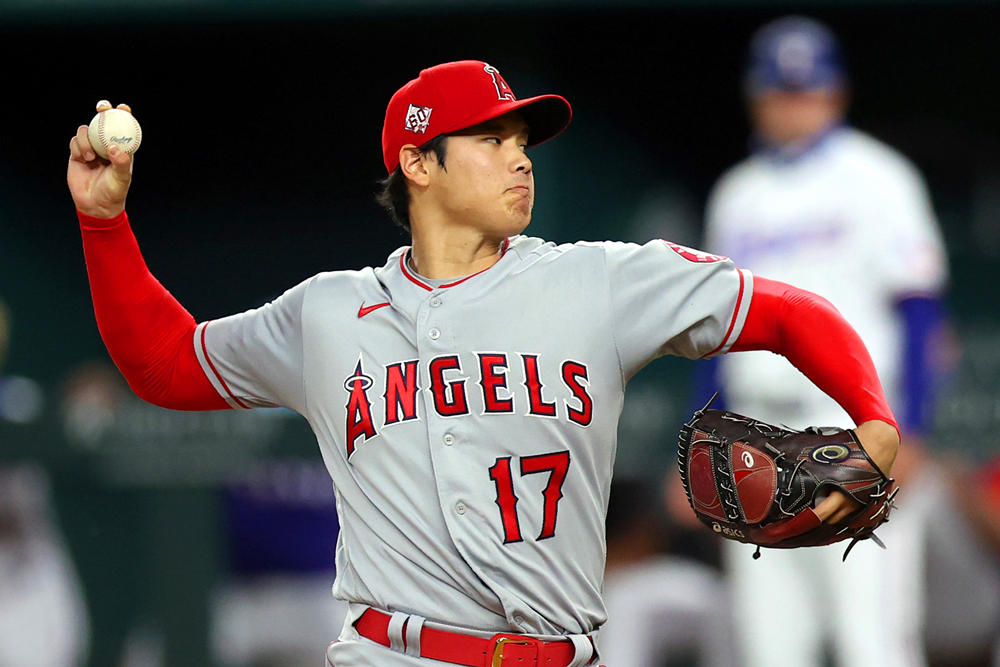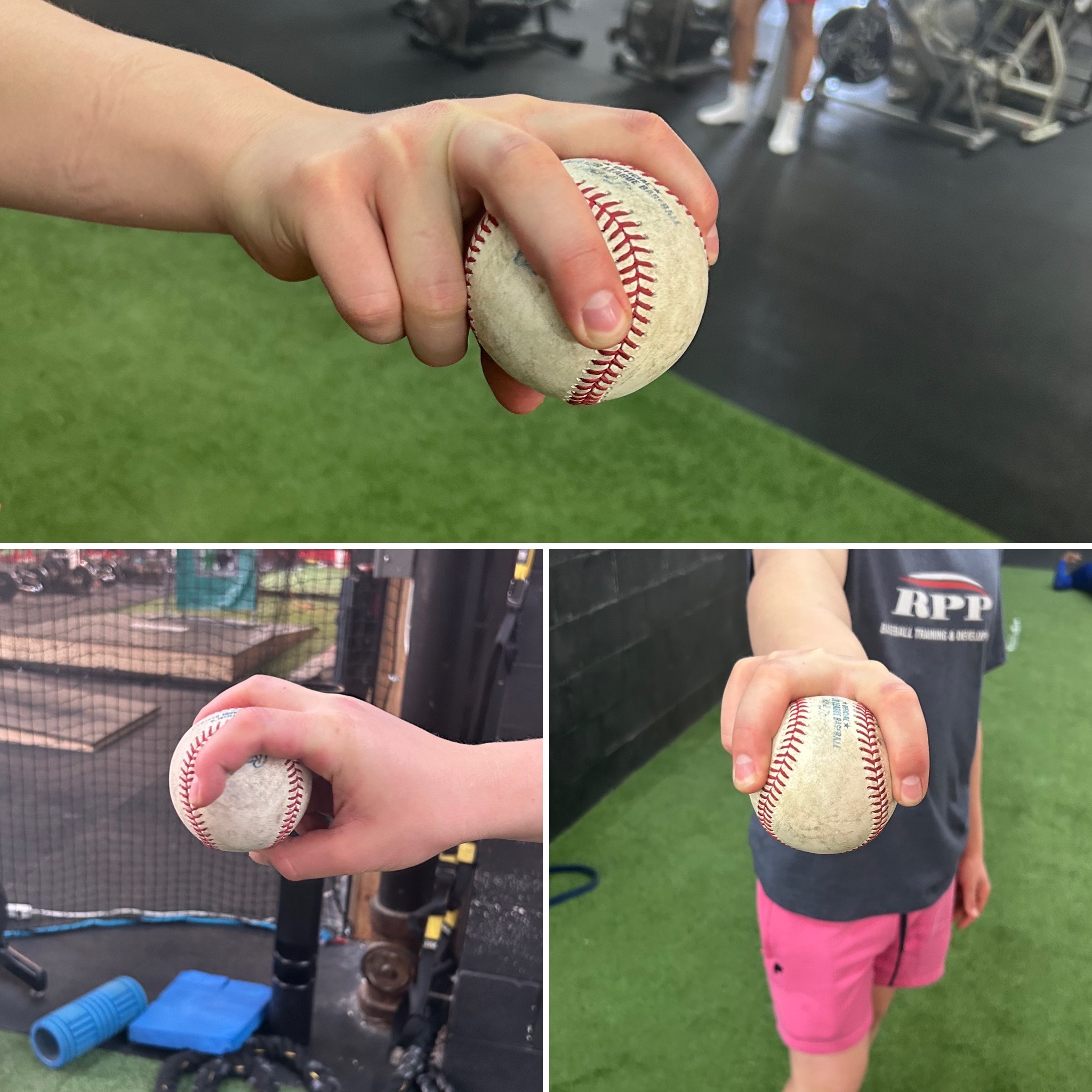
Baseball pitch grips are a big part of throwing a baseball. Every pitcher has a unique way of holding and gripping every pitch in his arsenal. Since the size of the baseball is “a given”, success with different pitches and baseball pitch grips can be attributable to many things, including hand size, finger size, finger pressure, finger placement, depth of the hold, hand / finger dexterity and most importantly comfort. In this article we are going to review the eight major pitch types, each with its own distinct baseball pitch grip and movement pattern:
-
- 4-seam Fastball Grip
- Sinker Grip / 2-seam Fastball Grip
- Cutter Grip
- Changeup Grip
- Curveball Grip
- Slider Grip
- Sweeper Grip
- Splitter Grip
How to throw different baseball pitches? Every pitch is defined to a significant extent by its predominant spin direction and it’s a combination of the grip and the final point of release that determines the spin direction that’s generated. In the following guide, we will review pitch grips and the corresponding release points that generate each pitch movement.
For the purposes of this article, we are going to assume a pitcher with a 3/4 arm slot. In addition, for reference, below is an image of a hand with the name of each finger.
1. 4-Seam Fastball Grip
The fastball is the first pitch every young pitcher learns how to throw. It is the bread and butter of pitching. The more effective your fastball, the more effective the rest of your arsenal. To be an accomplished pitcher you need to command this pitch and be able to throw it hard. Below is the image for a typical 4-seam fastball grip. The index and middle fingers are generally ½ -1 inch apart from each other, with the tip of the fingers sitting perpendicular on top of the seams. The thumb should be placed underneath the ball. For an expanded discussion on how to throw a 4-seam fastball click here.

4-seam Fastball Grip
The 4-seam fastball movement is reliant on its back spin. The more back spin a 4-seam fastball has the more successful it can be. In order to generate this back spin, the fingers need to be pulling down through the baseball all the way until release. This is accomplished by releasing the ball off the index and middle fingers concurrently to generate pure back spin. Here is how it should look at the moment of release to get pure spin.

As a side note, if a fastball has too much tail or cut versus pure back spin, it’s considered to have an unintentional cut. You can click here for additional info on this topic.
2. 2-Seam Fastball Grip / Sinker Grip
There is always some discussion whether the 2-seam fastball and the sinker are actually the same pitch. For the purposes of this article, they are. The index and middle fingers are placed together along the seams on the narrow side of the baseball. The thumb should be placed under the ball. For an expanded discussion on how to throw a 2-seam or sinker click here.

2-seam Fastball Grip / Sinker Grip
The “sinking” movement of is highly dependent on the final moment of release. Below is a video of how it should appear at the moment of release to get the appropriate type of spin. If we want this pitch to sink, meaning we want it to have more horizontal movement than vertical movement, then we need to focus on having the ball leave our fingertips at the correct angle. In the video below, you can see how the fingers are pulling through and down to the side of the ball, vs. the 4-seam fastball release above which is strictly down through the ball.

If you’re interested in receiving our blogs, please enter your email address below!
3. Cutter Grip
The cutter grip can be similar to a 4-seam grip or 2-seam grip but with the middle and index fingers closer together. Thumb placement is underneath the ball. For an expanded discussion on how to throw a cutter click here.

Cutter Grip
A cutter’s movement pattern is created at the point of release. If you cut the back of the ball into four quadrants, you want to release the Cutter off of the bottom right quadrant of the baseball. This will allow the pitcher to create backspin with the pitch while still adding some degree of side / gyro spin that will create the “cut” action you are looking for. A Cutter should have more vertical movement than horizontal (the more vertical the better). However, the pitch still needs to be moving in the horizontal plane towards the pitcher’s glove side.

4. Changeup Grip
The Changeup is one of the more popular baseball pitch grips and has several variations, but the two most common types are: the standard Changeup and the Circle Changeup. The grip for a standard Changeup involves putting the ball comfortably in your hand. Some people prefer to have it in the palm of the hand, and some would prefer to keep it loose in the fingertips. Additionally, you would wrap your five fingers all around the ball with your middle and ring fingers on top of the ball, your index finger and little finger on the sides of the ball, and your thumb on the bottom of the ball. For an expanded discussion on how to throw a changeup click here.

Changeup Grip
For the Circle Changeup grip, your thumb and index fingers form a circle on the side of the ball, while the other three fingers are placed around the baseball.

Circle Changeup Grip
A Changeup is meant to be thrown with identical intent and arm speed of a fastball. The grip will result in the pitch coming in at a slower velocity creating a deceptive pitch. With the Changeup having less velocity than the fastball it is intended to “drop” as it crosses home plate. In addition, a Changeup with “run” can be even more effective since it will not only have lower velocity but also have a more horizontal movement pattern. So, it not only drops but also has “run” compared to a 4-seam fastball.

Interested in learning more about remote programs, you can simply click below to schedule a phone call.
5. Curveball Grip
A Curveball is another of the more popular baseball pitch grips and is meant to have top spin which helps create depth. The middle and index finger are held together, pressed up on the seam. The thumb is placed opposite of the middle finger and hugs the seam on the bottom of the ball. The ring and little fingers sit to the side of the ball. The location of the middle and index finger pressed up on the seam enhances the ability to “rip down” on baseball, allowing for more top spin, movement, and depth. The top spin is created at release as your fingers roll the ball forward. For an expanded discussion on how to throw a curveball click here.

Typical Curveball Grip
With a Spiked Curveball, your index finger is pressing into the baseball. The “spiked” grip forces the pitcher to maintain more of a stiff wrist and focus more on their middle finger pressure through ball release. This helps with maintaining a good hand path through the pitch which helps with overall direction and could also create more of a “ripping” or “pulling” feel for the middle finger to come off the ball.

Spiked Curveball Grip
The telltale sign of a good Curveball is one with a lot of top spin and vertical break. Depending on your arm slot, you can have varying degrees of horizontal versus vertical movement. A pure 12-6 Curveball could have 20-25 inches of vertical movement and only a few inches of horizontal movement. However, a pitcher with a lower arm slot may have more equal amounts of vertical and horizontal movement.

6. Slider Grip
The traditional slider grip places the fingers slightly off-center between the inner seams near the bottom of the horseshoe figure on the ball. The middle finger is placed directly on or near the seam, while the index finger is on the leather. For an expanded discussion on how to throw a slider click here.

Slider Grip
A traditional Slider is released very much like football, and you should be able to see a “football spiral” or “bullet-like” spin on this pitch. This bullet-like spin creates equal air pressure around the baseball, creating a pitch with less overall movement than others.

7. Sweeper Grip
The grip for the sweeper (also known as a frisbee Slider) can be identical to the traditional Slider. However, the release will be different creating a sideways spin similar to a frisbee. For an expanded discussion on how to throw a sweeper click here.

Sweeper Grip
The release on this pitch is more on the side of the ball than a traditional Slider so that you can create a side spin that helps the pitch move towards glove side. This pitch is intended to have less vertical movement and more lateral movement. The key with this pitch is to make sure you are not dropping your arm slot to create the intended lateral movement, which requires you to release the ball on the side to create that sideways spin.

8. Splitter Grip
The Splitter grip is exactly what it says. You split your middle and index finger on opposite sides of the baseball forming a V. It is a grip which requires long enough fingers that can grip the ball (which is difficult for young pitchers) and hold on to it until release. For an expanded discussion on how to throw a splitter click here.

Splitter Grip
The Splitter is thrown similarly to a fastball; however, the grip creates a reduced spin rate which causes the ball to drop sharply as it nears home plate. In the example below, this splitter has a spin rate of 286 whereas a typical fastball has spin rates approaching 2,000 or more.

Summary
The most important thing with trying out new baseball pitch grips is comfort, success, and patience. It is about trial and error, in order to perfect the grip and movement. When attempting new pitches, keep in mind that it might take a while before your new grip pays off in bullpens and game situations. A good example would be when Trevor Bauer first started working on, and throwing, his Sweeper. It took him 2 years to be able to perfect it and use it in games regularly. He actually stopped throwing it in the first year and it was not until the second season that it became one of his primary pitches.
When it comes to baseball pitch grips, it is about trial, error, practice, and patience… and then more patience and practice!
By Bahram Shirazi and Jake Lebovitch (RPP Baseball)
You live too far to train with us in-house at RPP? You can now train with us on a REMOTE basis.


